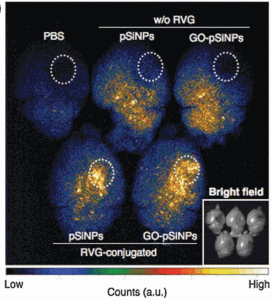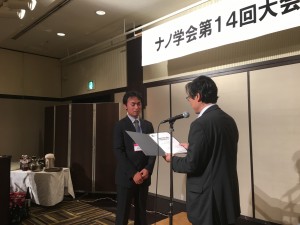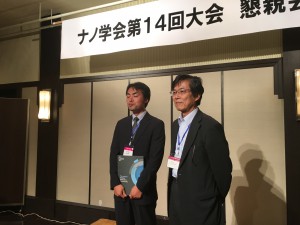
Time-gated luminescence image of injured mouse brains. Dashed white circles indicate region of penetrating brain injury. Targeted and nontargeted nanoparticles are compared. Inset: Bright field image (in gray scale) under ambient light.
A novel siRNA delivery system that could pave the way for genetic treatment of cancer, neurogenerative diseases or even HIV has been described in a new HOT article published in Nanoscale Horizons.
Over the last few years siRNA (small interfering RNA) has gained increasing attention as a new way to treat genetic diseases or viruses by silencing the genes responsible – the RNA fragments prevent the proteins that cause the illness from ever being expressed in the first place, making it the ultimate preventative therapy. However, current efforts have been hampered by the difficulty of delivering the delicate siRNA to the brain in one piece, before it’s degraded or attacked by the body’s immune defences.
This new system, developed by Michael Sailor’s team at the University of California, San Diego, uses porous silica nanoparticles as a protective carrier of the siRNA – the siRNA is hidden inside the pores of the nanoparticles where it’s protected from the body’s immune responses and harsh cell environments. A graphene oxide shell around the nanoparticles ensures that the siRNA stays safely inside them until they reach the brain. They will then release the still-intact siRNA, where it prevents sections of DNA from producing damaging proteins. The nanoparticles, which are fluorescent and easily tracked on their journey through the body, can be targeted to specific brain cells by attaching certain peptides; when the researchers attached rabies virus glycoprotein to the nanoparticles, their uptake by neuronal cells doubled. The system successfully silenced genes in cell cultures – even in the presence of RNA-degrading nucleases – and, promisingly, proved capable of delivering siRNA to the brains of live mice who had suffered brain injuries. Significantly more of the siRNA-carrying nanoparticles accumulated around damaged tissues than the healthy brain tissues, and released large quantities of siRNA once they got there.
Although it’s early days, the system shows great promise for genetic therapies using siRNA. By using siRNAs to silence the genes responsible for out-of-control replication of cells, it could one day be used in the prevention of cancer – and siRNAs targeted to viral proteins could even be used to successfully treat HIV.
Read the full article here:
Porous silicon–graphene oxide core–shell nanoparticles for targeted delivery of siRNA to the injured brain
Jinmyoung Joo, Ester J. Kwon, Jinyoung Kang, Matthew Skalak, Emily J. Anglin, Aman P. Mann, Erkki Ruoslahti, Sangeeta N. Bhatia and Michael J. Sailor
Nanoscale Horiz., 2016, Advance Article, DOI: 10.1039/C6NH00082G
Susannah May is a guest web writer for the RSC Journal blogs. She currently works in the Publishing Department of the Royal Society of Chemistry, and has a keen interest in biology and biomedicine, and the frontiers of their intersection with chemistry. She can be found on Twitter using @SusannahCIMay.














